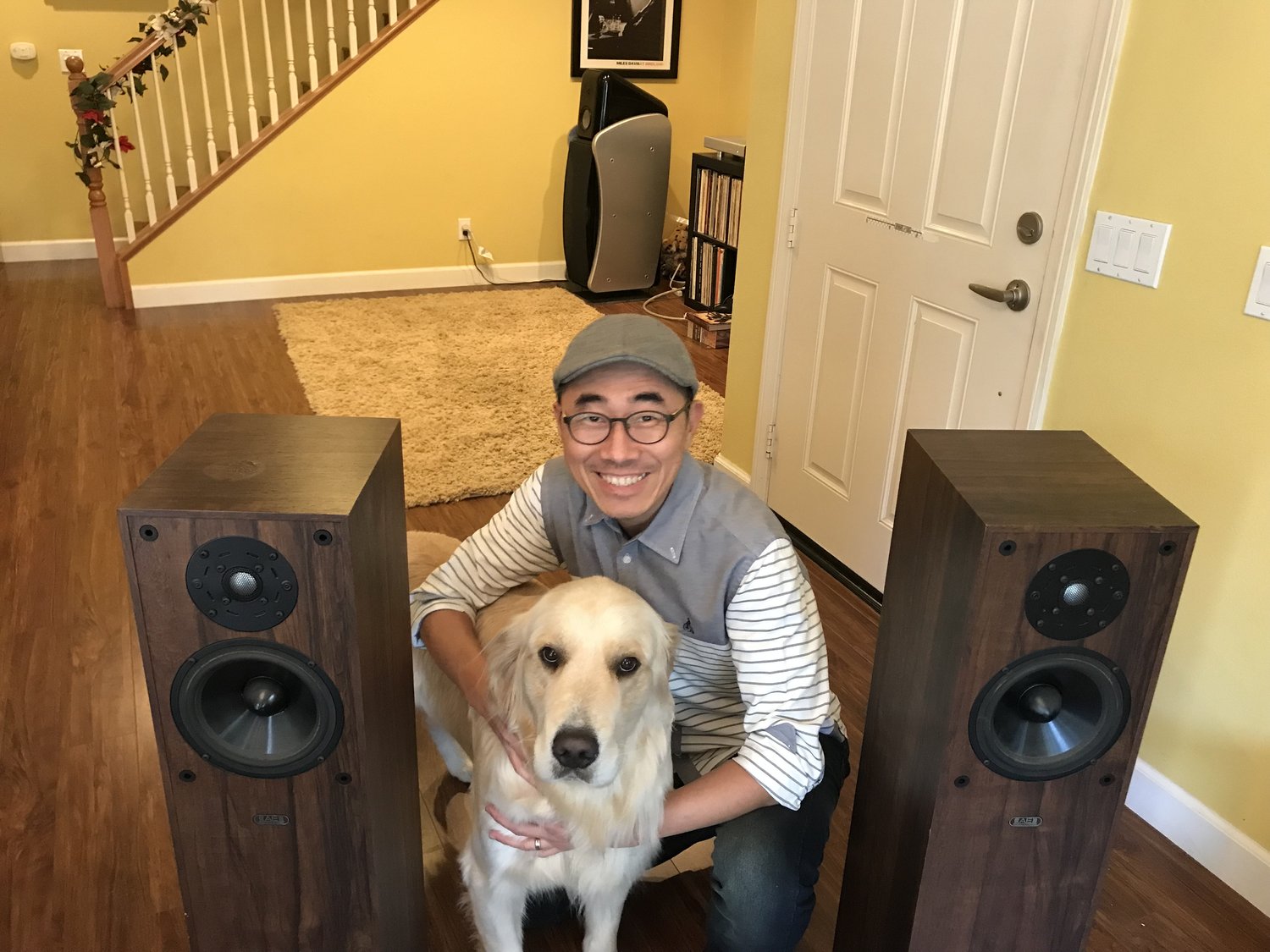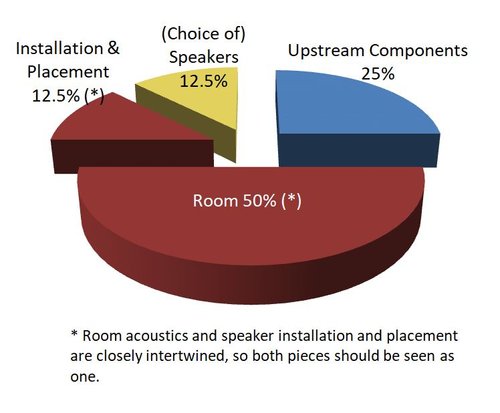
This may seem like a radically bold statement, but here goes: The choice of speakers accounts for 12.5% of the sound quality in your room. ‘How the heck did he get to that number?’, you may ask. That number is a half of a half of a half, a calculation I’ll explain soon.
I’ve owned 27 pairs of speakers so far. Some I couldn’t stand. Some I enjoyed. And there were four pairs I fell head over heels in love with (I’ve listed them below). Through my various endeavors to get the best sound out of them, I learned three things which led me to the 12.5% rule. Although this number is based on my personal experiences, it is, I believe, universally applicable.
Given the number of variables involved in sound reproduction, 12.5% for a component is not a small percentage. But the trouble is most of the time this percentage is much higher in some people’s heads—I’ve heard some people claim speakers are 80% of the sound we hear, then use this number to determine how much of their stereo budget to spend on speakers.
I’m convinced it’s the physical size and beauty of speakers in general that lead people to grant them more value than they deserve. Turntables and amplifiers look less dominant and are generally less attractive than speakers. Acoustic panels and component feet certainly don’t hold our attention or inspire our imagination as speakers can. Plus, speakers are in our face when we listen to music. The simple fact that we’re not blind can mislead us into assigning more importance to a speaker than we should. And that can be bad for our wallet.
So, without further ado, here are the 3 things I learned about speakers and how the 12.5% number came about:
1. We hear the room as much as the speakers
Our listening room isn’t a silent bystander. A lot of the sound that reaches our ears doesn’t come directly from our speakers but from the room itself. Our walls, floor, and ceiling all reflect the sound coming out of the speakers. Corners are especially troublesome. As per room treatment company Primacoustic’s website: “Acousticians have always employed corners as their starting point when absorbing sound energy. This is because the walls and ceilings (and floor for that matter) act as waveguides that work together to redirect sound into the corner. The ‘epicenter’ is the tri-corner where the walls and the ceiling intersect. This is without question, the eye of the hurricane.”
So, how much of what we hear is from the room and how much directly from the speakers, or, rather, the entire audio system? It depends on the room’s structure, its acoustics, how loud we listen to music (the louder, the more reflections), and how closely we sit to the speakers. My calculated guess is that the room itself is responsible for about half of what we hear.

2. Speakers should be nothing more than a window on to your upstream components
Audio is a game of omissions. No matter how much you glorify it, it comes down to trying to remove noise and distortion from the original signal. This truth contradicts impressions you may get from reading reviews, opinions, and comments about components, ones that suggest this amp creates a big soundstage, or this speaker delivers gobs of detail. Or even that cables made the music sound warmer. These kinds of descriptions are, ultimately, misleading. A component can only be a source of noise and distortion.
Speakers are no different. All they should do is play the signal loud enough without making its presence noted. But “disappearing” is not an easy feat for an audio component, especially a speaker, which is mechanical in nature and has cabinets and cones which are prone to causing distortion. Not only that, but along with the music, speakers reproduce the noise and distortion made by whatever precedes them—the amplifier, the preamp, and the source player.
So, how much noise and distortion come from the speakers and how much from the upstream gear? How important are the speakers in comparison to all the other components when it comes to fidelity? I’m a firm believer in first getting the source right, followed by every subsequent component after, because any part of the signal lost or distorted by a component can’t be restored by anything following it. That puts speakers at the end of the line. Still, a properly designed speaker is critical for getting the most accurate sound reproduction from the upstream components. I’ll say, then, that speakers account for about half the sound of the system itself.
3. How speakers are installed is as important as what they are
We now get to a speaker’s installation and placement inside the room. How far are the speakers from the walls and the listening position? What’s behind the speakers? What’s underneath them? Is the surface hard or soft? Is the speaker resting on harder spikes or softer isolation feet, on four “spike shoes” or on one solid surface like a granite slab? In my experience, the combination of these factors often plays a greater role in the sound than the make and model of the speakers themselves. Overall, I’d say these aspects determine about half of the speakers’ performance.
So, there you have it, a half of a half of a half of 100% = 12.5%.
Next time someone tells you they listened to XYZ speakers at some dealer or friend’s house, keep in mind the speaker model they proclaim to have listened to represents about 12.5% of the sound quality they heard. This will hopefully give you perspective for your next speaker purchase and maybe even save you money in the process.
***
And now, here are the speakers I fell in love with:
Revel Ultima Studio
It has the two qualities I value most in speakers—resolution and neutrality. With these criteria applied, they are the best-sounding speakers I’ve owned. They’re my current pair and are not going anywhere.
Magnepan MG-2.5R
For the longest time, these were my favourites. They possessed the most natural timbre I’d heard. My pair comes with an upgraded crossover box and custom stands from Mye Sound (myesound.com). Some say bass is Magnepan’s Achilles’ heel but not so with these upgrades. My Maggies go down to 28Hz (about 10Hz lower than the original spec). They stepped aside for the Revels but I ain’t selling them.
Energy Veritas 2.2
Inexpensive yet gorgeous-sounding. These bookshelves are screwed down to the heavy stands that come with the model, which makes a huge difference in terms of bass response. For those on a tight budget, they could be your last speakers.
Usher CP-6381
Three adults were needed to carry these heavy beasts into my listening space. But they were totally worth the effort, at least for me. It was a long time ago when I had them but my memory tells me they sounded similar to the Revels.
Runners up (speakers I enjoyed very much):
Bowers & Wilkins Nautilus 804
Martin Logan Vantage
Vandersteen 2Ce
Acoustic Energy AEGIS Model 2 (This was a wedding gift from my wife and I’ve been cherishing it. It’s the rosewood version from the mid-90s, not the model commonly known as AEGIS 2.)
And that’s it from me this year. HAPPY NEW YEAR EVERYONE!
Read more of this series:
· 3 Things I Learned About… Amplifiers
· 3 Things I Learned About… Interconnects
· 3 Things I Learned About… Digital Playback
· 3 Things I Learned About… Magnepan Speakers
TO SUBMIT YOUR OWN “3 THINGS I LEARNED ABOUT… “ ARTICLE (IT CAN BE ABOUT ANYTHING AUDIO-RELATED), SEND IT HERE.











Leave a Reply